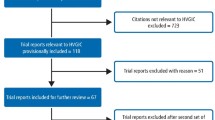Abstract
Data sources
Cochrane Oral Health's Trials Register, Cochrane Central Register of Controlled Trials (CENTRAL), Medline, Embase, LILACS, SciELO, Chinese BioMedical Literature Database, VIP, China National Knowledge Infrastructure, ClinicalTrials.gov, World Health Organization International Clinical Trials Registry Platform, OpenGrey and Sciencepaper Online databases. Handsearches in a number of journals.
Study selection
Randomised controlled trials, including split-mouth studies assessing the effects of rubber dam isolation for restorative treatments in dental patients.
Data extraction and synthesis
Two review authors independently screened the results of the electronic searches, extracted data and assessed the risk of bias of the included studies.
Results
Four studies involving a total of 1,270 patients were included. The studies were at high risk of bias. One trial was excluded from the analysis due to inconsistencies in the presented data. Restorations had a significantly higher survival rate in the rubber dam isolation group compared to the cotton roll isolation group at six months in participants receiving composite restorative treatment of non-carious cervical lesions (risk ratio (RR) 1.19, 95% confidence interval (CI) 1.04 to 1.37, very low-quality evidence). The rubber dam group had a lower risk of failure at two years in children undergoing proximal atraumatic restorative treatment in primary molars (hazard ratio (HR) 0.80, 95% CI 0.66 to 0.97, very low-quality evidence). One trial reported limited data showing that rubber dam usage during fissure sealing might shorten the treatment time. None of the included studies mentioned adverse effects or reported the direct cost of the treatment, or the level of patient acceptance/satisfaction. There was also no evidence evaluating the effects of rubber dam usage on the quality of the restorations.
Conclusions
We found some very low-quality evidence, from single studies, suggesting that rubber dam usage in dental direct restorative treatments may lead to a lower failure rate of the restorations, compared with the failure rate for cotton roll usage. Further high quality research evaluating the effects of rubber dam usage on different types of restorative treatments is required.
Similar content being viewed by others
Commentary
The benefit of using rubber dam for endodontic treatment has long been recognised. Not only has it been found to improve endodontic outcomes,1 but also protects tissues from potentially harmful irrigants and guards the airway when using fine endodontic instruments which could pose an aspiration risk.2This Cochrane systematic review sets out with a clear objective to compare the effects of rubber dam isolation to other forms of isolation used in the placement of both direct and indirect restorations. The two primary outcomes are stated as: the survival rate of restorations at six months, one, two, five and ten years and any reported adverse events. The reviewers also aim to consider a number of secondary outcomes which include the assessment of restoration quality, cost and patient satisfaction.
As we would expect from a systematic review which follows the Cochrane methodology, a comprehensive literature search strategy was employed. This included searching for articles published up to 2016 with no language or geographical restrictions. Nine databases were searched including MEDLINE, Embase Ovid and the Cochrane Central Register of Controlled Trials. The reviewers also describe carrying out an extensive hand search of relevant journals, and contacting authors as well as experts in the field to identify any unpublished trials. Both randomised and quasi-randomised control trials were considered for inclusion in the review if they comprised of an intervention arm with treatment under rubber dam and a control arm with treatment using another form of moisture control. Included trials could involve any type of direct or indirect restoration with no age or gender restrictions. In spite of these relatively broad inclusion criteria only four trials were identified which could be included in the systematic review.
The reviewers assess bias using the Cochrane Risk of Bias Tool.3 This enables a clear assessment of potential biases in the design, conduct, analysis, and reporting of the included studies. The appraisal clearly demonstrates that all four included studies have a high risk of bias. The main domains where bias was noted were in receiving industrial funding (2 studies) and a lack of blinding of both patient and operator (4 studies). The later should be interpreted with some caution as it is important to remember that both patient and clinician cannot be blinded as to whether rubber dam was used or not. Blinding of the assessor who reviewed the restorations at follow-up was described in two of the studies.
Of the included studies, three reported outcomes in children who required fissure sealants and the restoration of primary molars. The remaining study included the restoration of non-carious cervical lesions under rubber dam. Due to the differences in the patient groups, clinical procedures and outcome measures the results from the studies could not be combined and so, although planned, a meta-analysis was not carried out. The authors provide a narrative review of all four studies and summary statistics for only one. Results from two of the studies included in the systematic review demonstrated inconsistent reporting. Only one study demonstrated a significant difference of survival rate in favour of restorations placed under rubber dam. This study was however was deemed to be of ‘very low quality’ when assessed using the GRADE4 assessment tool meaning that we can be very uncertain about this estimate.
None of the studies commented on either the ‘adverse event’ primary outcome, or any of the secondary outcomes of the review. A notable limitation of this review is that decisions around whether the use of rubber dam may improve the survival of restorations could only be drawn from one single study of very low quality evidence. The reviewers indeed conclude that “further high quality research evaluating the effects of rubber dam usage on different types of restorative treatments is required”.
As typical of a Cochrane systematic review, a robust methodology was followed which allowed the reviewers to identify a lack of high quality randomised control trials that assess the use of rubber dam isolation in restorative dentistry. Worthy of note is that included studies only looked at the use of direct resin based restorations; none included other common restoration types or materials such as crowns or inlays and amalgam. It is therefore reasonable to conclude that the results of this systematic review would be unsupported as evidence to alter current practice.
References
Lin PY, Huang SH, Chang HJ, Chi LY . The effect of rubber dam usage on the survival rate of teeth receiving initial root canal treatment: a nationwide population-based study. J Endod 2014; 40: 1733–1737.
Carrotte P . Endodontics: Part 6 Rubber dam and access cavities. Br Dent J 2004; 197: 527–534.
Higgins JPT, Green S (editors). Cochrane Handbook for Systematic Reviews of Interventions version 5.1.0 (updated March 2011).
Atkins D, Best D, Briss PA, et al.; GRADE Working Group. Grading quality of evidence and strength of recommendations. Br Med J 2004; 328:1490.
Author information
Authors and Affiliations
Additional information
Address for correspondence: Luisa Fernandez Mauleffinch, Managing Editor, Cochrane Oral Health Group, School of Dentistry, The University of Manchester, JR Moore Building, Oxford Road, Manchester, M13 9PL, UK. E-mail: luisa.fernandez@manchester.ac.uk
Wang Y, Li C, Yuan H, Wong MC, Zou J, Shi Z, Zhou X. Rubber dam isolation for restorative treatment in dental patients. Cochrane Database Syst Rev 2016; 9: Art. No. CD009858. DOI: 10.1002/14651858.CD009858.pub2.
This paper is based on a Cochrane Review published in the Cochrane Library 2016, issue 9 (see www.thecochranelibrary.com for information). Cochrane Reviews are regularly updated as new evidence emerges and in response to feedback, and the Cochrane Library should be consulted for the most recent version of the review.
Rights and permissions
About this article
Cite this article
Keys, W., Carson, S. Rubber dam may increase the survival time of dental restorations. Evid Based Dent 18, 19–20 (2017). https://doi.org/10.1038/sj.ebd.6401221
Published:
Issue Date:
DOI: https://doi.org/10.1038/sj.ebd.6401221



